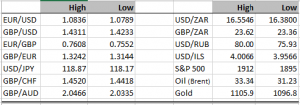From an Elliott wave perspective the recent low in the S&P 500 and other equity markets could mark the conclusion of the recent market turbulence. Interestingly the peak to trough move is an almost exact match for the late summer China turbulence the caused so much panic in August and September. In Elliott Wave speak we describe the move as an ABC, where A=C (I refer you to the illustration of the S&P 500 in the 20th January blog I posted). I bring this up, for a couple of reasons, (i) we are now monitoring the recent low as a key level, a move below could open the way for more worrying losses, but (ii) risk sentiment may just be about to recover and that will certainly have an impact on currency markets as well.
Those who argued against the December Fed rate hike are going on the attack now. With all the gloom and doom surrounding China and the global economy in general, the poor manufacturing indicators in the United States etc., more and more people are coming out to say that the Federal Reserve was premature in hiking. Maybe, maybe not. As I’ve often said I really don’t see a 25bps hike doing too much harm. But what matters in markets is expectations, and the big question now is whether markets will start seriously pricing in a reversal of the Federal Reserve move. If that happens that could be damaging for the dollar. There are arguments on both sides, but there’s not much point in my re-hashing what I’ve said in favour of normalising rates and exiting this long period of extraordinary monetary policy, you can find those musings in many of the blogs I’ve written over the last half year. The case in favour of a reassessment of Federal Reserve policy is the weakness in global growth, the lack of wage inflation, market turbulence and the disinflationary threat of a weakening Chinese currency (as the renminbi weakens the cost of imported Chinese goods is lower and thus puts downward pressure on US consumer prices). But here’s the thing.. most economists when pushed will agree that the risk of a US recession is very low, but the markets are pricing is an almost 50% chance of one, if the market re-assesses that we could get a rally of some sort. As long as economists maintain a positive outlook for the US economy it’s unlikely that we’ll get a retreat from the Federal Reserve, and this is only right. When you also add in the fact that there would be a huge knock to credibility and indeed corporate pride at the Federal Reserve it becomes clear that something really really bad would have to happen for a cut in interest rates to happen. Obviously that’s not going to stop markets from pining after the era of central bank largesse, but it’s important to maintain a firm grasp on reality.
Elsewhere, the price of oil has jumped by over 10% over the last week. Trends never move in a straight line and clearly the market became a tad oversold and we are now seeing a recovery of some sort. I have real doubts about how long that lasts though, as fundamentally market oversupply and weak demand will cap any rally in this market and it will take a substantial period of reduced investment in production capacity for a solid bullish case for oil to develop. That could take years.
There was a rather disturbing article published in the Financial Times about the level of stressed emerging market debt having grown larger than the previous peak at the height of the Global Financial Crisis. This for me is the main systemic risk facing the global economy in 2016. It’s so hard to predict where the danger spots are until after they become public knowledge. Panics are always greater when trouble comes unexpectedly. This raises another point about the collateral damage that could occur in the global economy in the months ahead. With emerging market economies weakening, and more importantly their currencies weakening, there will be much lower demand to recycle export earnings into US treasuries, indeed if the renminbi continues to weaken at its current pace we could see substantial amounts of US treasuries being sold. If this is the case the Federal Reserve won’t have to tighten further, the market will do it automatically. This is another reason why there is a risk of a retreat in Fed tightening policy. The bottom line is that it is not clear that there is much of a case for the greenback to continue strengthening aggressively at this point. Please note however that that is a far cry from presenting a case for the dollar to weaken. As my thoughts evolve I will be sure to let you know…
DISCLAIMER
Any financial promotion contained herein has been issued and approved by ParityFX Plc (“ParityFX”); a firm authorised and regulated by the Financial Conduct Authority (“FCA”) as a Payment Services Institution with registration number 606416. It is for informational purposes and is not an official confirmation of terms. It is not guaranteed as to accuracy, nor is it a complete statement of the financial products or markets referred to.
Opinions expressed are subject to change without notice and may differ or be contrary to the opinions or recommendations of ParityFX. Unless stated specifically otherwise, this is not a recommendation, offer or solicitation to buy or sell and any prices or quotations contained herein are indicative only. To the extent permitted by law, ParityFX does not accept any liability arising from the use of this communication.
Follow our tweets @parityfxplc
Follow us on LinkedIn ParityFX Plc
